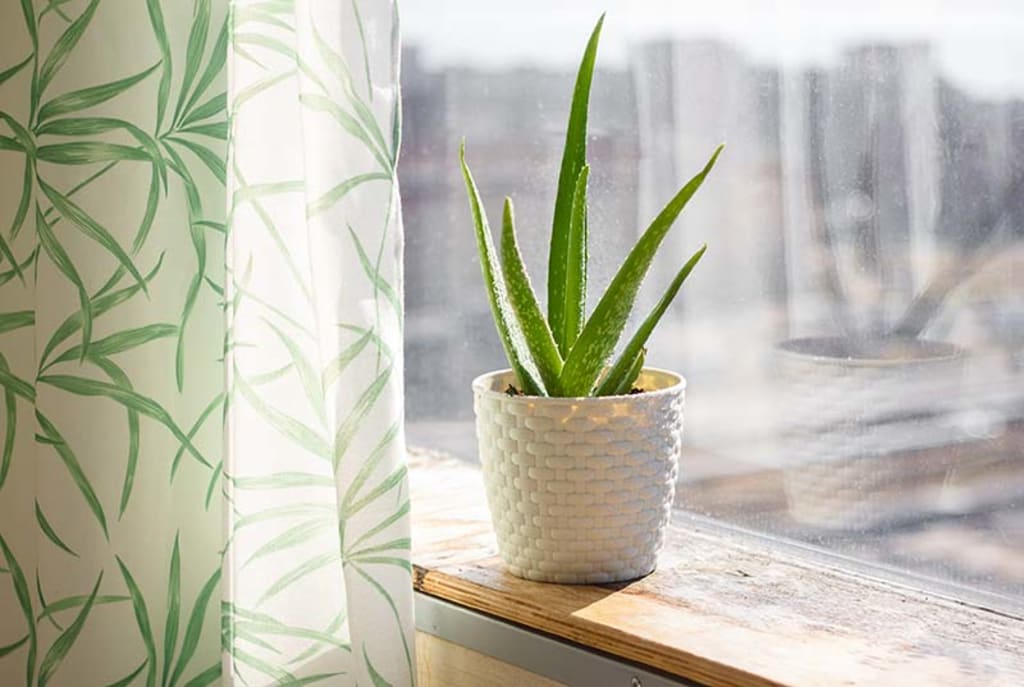Growing Aloe Vera
Caring for Container Plants

You don’t have to have a green thumb to grow an aloe vera plant, nor do you have to live in the desert Southwest. You just need to know some basic tips to grow and maintain the succulent. Whether you are an expert gardener or a beginner, you will find this plant a joy to cultivate and grow.
This short-stemmed plant displays fleshy and thick green lanceolate leaves that fan out from the middle. When growing the plant indoors, find a bright area that receives indirect sunlight. Never place aloe vera directly in the sun inside, as doing so will dry it out. If your aloe’s leaves turn yellow, the plant is receiving too much light.
If you can find a spot in the kitchen to set your plant, you can use the plant’s clear gel for mixing smoothies or for topically treating abrasions or burns. Cut open one of the plant’s leaves to extract the clear gel. However, be careful about the latex.
Completely wash off the yellow substance, also contained in the leaves, before using the gel. The latex triggers severe stomach upset and is considered toxic when consumed, even in small quantities.
Planting Your Aloe Vera Plant
To plant your aloe vera plant, you will need to follow the steps below.
1. Remove the aloe vera plant from its container, softly brushing excess dirt from the roots.
2. Before placing the plant in its new container, rinse the pot and position a small screen beneath the drain hole. This will serve two purposes. It will promote drainage and keep the soil intact. If a screen is not available, use a thick piece of paper towel as a temporary measure.
3. Fill the planter one-third full with potting mix before placing the plant. Use a potting soil that promotes good drainage.
4. After positioning the plant, fill the remainder of the pot with soil, leaving just under an inch between the dirt and rim. The bottom of the leaves should rest just above the dirt. Wait to water the plant for about a week. Overwatering can kill an aloe vera.
5. Place the plant in a spot that receives bright yet indirect sunlight. Preferably, place the plant next to a southern or western window. Plants that do not receive enough light tend to grow leggy.
6. Maintain a temperature between 60 degrees and 85 degrees Fahrenheit, or between 15 degrees and 25 degrees Celsius, in the room where you place the plant.
7. You can place your indoor aloe vera plants outside in most zones in the U.S. from May to September. Place the container plants indoors when evenings are cool, or when the temperature drops to 60 degrees Fahrenheit or around 15 degrees Celsius.
A Tip on Watering
-When you do water your aloe vera plant, water it deeply. Wait until the soil dries to a depth of about two inches. Check the dryness of the dirt with your fingers.
-Never allow the plant to sit in water. Nor do you want to water the plant frequently, as doing so will lead to the development of root rot.
Water the plant, during warmer times, about every three weeks, and less frequently during the winter.
Getting Your Adult Plant to Flower
Often, it can be tough to promote flowering of an indoor aloe vera plant. However, most of the plants, at least three years old, will bloom with the right encouragement.
The plant shows off its tubular red or yellow flowers on a tall spike, so a blooming plant can look quite dramatic. To encourage blooming of a container plant, do the following:
-Give your plant as much natural light as you can, particularly during the spring and summer. Therefore, keep the plant outside in the full sun for about six hours. However, don’t place your aloe plant too quickly in a bright location. Instead, place the plant in partial shade first for a week. Transition it after this time to the sunnier spot.
-If you place the plant outside, protect it from excesses in rainfall. Always take the plant inside if heavy rains are forecast.
-Place your plant outdoors when the temperature climbs above 70 degrees Fahrenheit or 20 degrees Celsius.
Maintain dormancy for your aloe plants in the fall and winter. Doing so will promote flowering in the spring.
In Summation –
Avoid giving your aloe plants too much water while providing them with plenty of indirect natural light. If you remember these two basic rules, you can enjoy your container plants for a long, long time.
About the Creator
Donna Ryan
Experienced writer and editor. Subjects I've covered include health and fitness, home and gardening, technology, travel, business, and general news content.






Comments
There are no comments for this story
Be the first to respond and start the conversation.